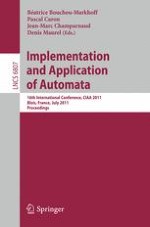2011 | Book
Implementation and Application of Automata
16th International Conference, CIAA 2011, Blois, France, July 13-16, 2011. Proceedings
Editors: Béatrice Bouchou-Markhoff, Pascal Caron, Jean-Marc Champarnaud, Denis Maurel
Publisher: Springer Berlin Heidelberg
Book Series : Lecture Notes in Computer Science
